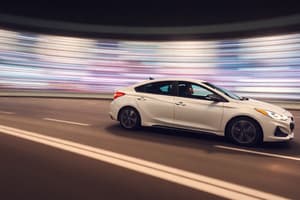Podcast
Questions and Answers
Motion is described with respect to a:
Motion is described with respect to a:
- Frame of reference (correct)
- Slope
- Graph
- Displacement
Displacement is distance combined with:
Displacement is distance combined with:
- Speed
- Velocity
- Direction (correct)
- Magnitude
Displacement vectors of 3 m and 5 m in the same direction combine to make a displacement vector that is:
Displacement vectors of 3 m and 5 m in the same direction combine to make a displacement vector that is:
- 0 m
- 8 m (correct)
- 2 m
- 15 m
Average speed is the total distance divided by the:
Average speed is the total distance divided by the:
The slope of a distance-time graph is equal to the:
The slope of a distance-time graph is equal to the:
Velocity is:
Velocity is:
Two or more velocities can be combined by:
Two or more velocities can be combined by:
A ball just dropped is an example of:
A ball just dropped is an example of:
Acceleration is equal to:
Acceleration is equal to:
The rate at which velocity is changing at a given instant is described by:
The rate at which velocity is changing at a given instant is described by:
Why is it necessary to choose a single frame of reference when measuring motion?
Why is it necessary to choose a single frame of reference when measuring motion?
For what kinds of distances would you choose to make measurements in millimeters? In kilometers?
For what kinds of distances would you choose to make measurements in millimeters? In kilometers?
Light from a star travels to Earth in a straight line at a constant speed of almost 300,000 km/s. What is the acceleration of the light?
Light from a star travels to Earth in a straight line at a constant speed of almost 300,000 km/s. What is the acceleration of the light?
If two displacement vectors add to yield a total displacement of zero, what do you know about the two displacements?
If two displacement vectors add to yield a total displacement of zero, what do you know about the two displacements?
How will the total distance traveled by a car in 2 hours be affected if the average speed is doubled?
How will the total distance traveled by a car in 2 hours be affected if the average speed is doubled?
How do you know that a speedometer tells you the instantaneous speed of a car?
How do you know that a speedometer tells you the instantaneous speed of a car?
On a distance-time graph, what would the curve describing constant speed look like?
On a distance-time graph, what would the curve describing constant speed look like?
A spider is crawling on a wall. First it crawls 1 m up, then 1 m to the left, and then 1 m down. What is its total displacement?
A spider is crawling on a wall. First it crawls 1 m up, then 1 m to the left, and then 1 m down. What is its total displacement?
A jogger travels 8.0 km in 1.25 h. What is the jogger's average speed?
A jogger travels 8.0 km in 1.25 h. What is the jogger's average speed?
You see a lightning bolt in the sky. You hear a clap of thunder 3 seconds later. The sound travels at a speed of 330 m/s. How far away was the lightning?
You see a lightning bolt in the sky. You hear a clap of thunder 3 seconds later. The sound travels at a speed of 330 m/s. How far away was the lightning?
If a river current is 8.0 m/s, and a boat is traveling 10.0 m/s upstream, what is the boat's speed relative to the riverbank?
If a river current is 8.0 m/s, and a boat is traveling 10.0 m/s upstream, what is the boat's speed relative to the riverbank?
If an object is moving with constant velocity, what do you know about its acceleration?
If an object is moving with constant velocity, what do you know about its acceleration?
If the plotted points on a speed-time graph do not form a straight line, what do you know about the object's acceleration?
If the plotted points on a speed-time graph do not form a straight line, what do you know about the object's acceleration?
Explain a situation in which you can accelerate even though your speed doesn't change.
Explain a situation in which you can accelerate even though your speed doesn't change.
A girl moves at 2 m/s delivering newspapers. She throws a newspaper directly behind her at 2 m/s. In the frame of reference of someone standing nearby, what is the motion of the newspaper?
A girl moves at 2 m/s delivering newspapers. She throws a newspaper directly behind her at 2 m/s. In the frame of reference of someone standing nearby, what is the motion of the newspaper?
Design an experiment to measure the speed of a toy train going around a circular track.
Design an experiment to measure the speed of a toy train going around a circular track.
A raft floats downstream. After 1 minute it has moved 50.0 m. After 2 mins it has moved 100.0 m. After 3 min it has moved 150.0 m. Could the raft's speed be constant? Explain.
A raft floats downstream. After 1 minute it has moved 50.0 m. After 2 mins it has moved 100.0 m. After 3 min it has moved 150.0 m. Could the raft's speed be constant? Explain.
A rocket ship is moving through space at 1000 m/s. It accelerates in the same direction at 4 m/s^2. What is its speed after 100 s?
A rocket ship is moving through space at 1000 m/s. It accelerates in the same direction at 4 m/s^2. What is its speed after 100 s?
If a displacement-time graph goes steadily up and then flattens out, describe the history of the motion.
If a displacement-time graph goes steadily up and then flattens out, describe the history of the motion.
If a displacement-time graph goes steadily up to 15 meters at 10 seconds and flattens out, how fast is the person walking during the first 10 s?
If a displacement-time graph goes steadily up to 15 meters at 10 seconds and flattens out, how fast is the person walking during the first 10 s?
A car starts from rest and increases its speed to 15 m/s in 20 s. What is the car's acceleration?
A car starts from rest and increases its speed to 15 m/s in 20 s. What is the car's acceleration?
The propulsion system of a rocket ship moving through space at 1000 m/s with an acceleration rate of 4 m/s/s is tested. Its rockets are fired and the ship accelerates from rest at 5 m/s/s for 2 min. How does the ship's final velocity compare to the initial velocity of the first testing?
The propulsion system of a rocket ship moving through space at 1000 m/s with an acceleration rate of 4 m/s/s is tested. Its rockets are fired and the ship accelerates from rest at 5 m/s/s for 2 min. How does the ship's final velocity compare to the initial velocity of the first testing?
Compare the case of a rubber ball falling through the air and a rubber ball bouncing up and down on a hard floor. For which of these cases is the instantaneous acceleration always the same as the constant acceleration?
Compare the case of a rubber ball falling through the air and a rubber ball bouncing up and down on a hard floor. For which of these cases is the instantaneous acceleration always the same as the constant acceleration?
Two trains on parallel tracks are traveling in the same direction. One train starts 10 km behind the other. It overtakes the first train in 2 h. What is the relative speed of the second train with respect to the first train?
Two trains on parallel tracks are traveling in the same direction. One train starts 10 km behind the other. It overtakes the first train in 2 h. What is the relative speed of the second train with respect to the first train?
Flashcards are hidden until you start studying
Study Notes
Motion and Reference Frames
- Motion is measured relative to a frame of reference, necessary for clear measurements.
- Velocity is defined as speed with direction.
Displacement
- Displacement incorporates distance with direction, crucial for determining overall movement.
- Displacements can be combined; for instance, a 3 m and 5 m vector in the same direction results in an 8 m vector.
Speed and Acceleration
- Average speed is calculated by total distance over total time.
- Acceleration is defined as the change in speed divided by time, with constant velocity indicating zero acceleration.
Graph Interpretation
- The slope of a distance-time graph represents speed; a straight line indicates constant speed.
- Speed-time graphs that do not form straight lines indicate non-constant acceleration.
Real-Life Applications
- An average speed increase results in doubled total distance over the same time span.
- A situation where speed remains constant but motion changes direction exemplifies acceleration without speed change.
Measurement and Context
- Small distances are measured in millimeters, while large distances are measured in kilometers for clarity.
- Instantaneous speed is observed at a specific moment, such as on a car's speedometer.
Relative Motion
- The relative speed of objects, such as trains or boats, can differ based on their respective frames of reference.
- E.g., a boat moving upstream against a current has a different speed relative to the riverbank compared to its speed in the water.
Time and Distance Relationships
- Calculating distance can involve methods like timing an object traveling around a defined path.
- For example, a light traveling at nearly 300,000 km/s has an acceleration of 0 km/s/s since its speed remains constant.
Motion in Different Directions
- Total displacement can vary significantly when moving in multiple directions, exemplified by a spider's movements.
- A raft that moves consistently downstream can have constant speed, despite the incremental increase in distance over time.
Velocity and Changes in Speed
- A rocket's velocity increases due to constant acceleration; comparisons to previous velocities can indicate performance changes.
- Instantaneous acceleration can differ between actions, such as falling versus bouncing, highlighting different acceleration dynamics based on context.
Studying That Suits You
Use AI to generate personalized quizzes and flashcards to suit your learning preferences.




